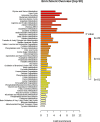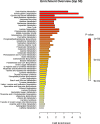Relationship Between Inflammation and Metabolism in Patients With Newly Presenting Rheumatoid Arthritis
- PMID: 34650548
- PMCID: PMC8507469
- DOI: 10.3389/fimmu.2021.676105
Relationship Between Inflammation and Metabolism in Patients With Newly Presenting Rheumatoid Arthritis
Abstract
Background: Systemic inflammation in rheumatoid arthritis (RA) is associated with metabolic changes. We used nuclear magnetic resonance (NMR) spectroscopy-based metabolomics to assess the relationship between an objective measure of systemic inflammation [C-reactive protein (CRP)] and both the serum and urinary metabolome in patients with newly presenting RA.
Methods: Serum (n=126) and urine (n=83) samples were collected at initial presentation from disease modifying anti-rheumatic drug naïve RA patients for metabolomic profile assessment using 1-dimensional 1H-NMR spectroscopy. Metabolomics data were analysed using partial least square regression (PLS-R) and orthogonal projections to latent structure discriminant analysis (OPLS-DA) with cross validation.
Results: Using PLS-R analysis, a relationship between the level of inflammation, as assessed by CRP, and the serum (p=0.001) and urinary (p<0.001) metabolome was detectable. Likewise, following categorisation of CRP into tertiles, patients in the lowest CRP tertile and the highest CRP tertile were statistically discriminated using OPLS-DA analysis of both serum (p=0.033) and urinary (p<0.001) metabolome. The most highly weighted metabolites for these models included glucose, amino acids, lactate, and citrate. These findings suggest increased glycolysis, perturbation in the citrate cycle, oxidative stress, protein catabolism and increased urea cycle activity are key characteristics of newly presenting RA patients with elevated CRP.
Conclusions: This study consolidates our understanding of a previously identified relationship between serum metabolite profile and inflammation and provides novel evidence that there is a relationship between urinary metabolite profile and inflammation as measured by CRP. Identification of these metabolic perturbations provides insights into the pathogenesis of RA and may help in the identification of therapeutic targets.
Keywords: cachexia; citrate cycle; glycolysis; inflammation; metabolism; oxidative stress; rheumatoid arthritis; urea cycle.
Copyright © 2021 Jutley, Sahota, Sahbudin, Filer, Arayssi, Young and Raza.
Conflict of interest statement
The authors declare that the research was conducted in the absence of any commercial or financial relationships that could be construed as a potential conflict of interest.
Figures








Similar articles
-
The impact of inflammation on metabolomic profiles in patients with arthritis.Arthritis Rheum. 2013 Aug;65(8):2015-23. doi: 10.1002/art.38021. Arthritis Rheum. 2013. PMID: 23740368 Free PMC article.
-
Exploration of the serum metabolite signature in patients with rheumatoid arthritis using gas chromatography-mass spectrometry.J Pharm Biomed Anal. 2016 Aug 5;127:60-7. doi: 10.1016/j.jpba.2016.02.004. Epub 2016 Feb 4. J Pharm Biomed Anal. 2016. PMID: 26879423
-
Urinary metabolomic biomarker candidates for skeletal muscle wasting in patients with rheumatoid arthritis.J Cachexia Sarcopenia Muscle. 2023 Aug;14(4):1657-1669. doi: 10.1002/jcsm.13240. Epub 2023 May 26. J Cachexia Sarcopenia Muscle. 2023. PMID: 37243418 Free PMC article.
-
Translational Metabolomics of Head Injury: Exploring Dysfunctional Cerebral Metabolism with Ex Vivo NMR Spectroscopy-Based Metabolite Quantification.In: Kobeissy FH, editor. Brain Neurotrauma: Molecular, Neuropsychological, and Rehabilitation Aspects. Boca Raton (FL): CRC Press/Taylor & Francis; 2015. Chapter 25. In: Kobeissy FH, editor. Brain Neurotrauma: Molecular, Neuropsychological, and Rehabilitation Aspects. Boca Raton (FL): CRC Press/Taylor & Francis; 2015. Chapter 25. PMID: 26269925 Free Books & Documents. Review.
-
Metabolomics in rheumatoid arthritis: Advances and review.Front Immunol. 2022 Aug 11;13:961708. doi: 10.3389/fimmu.2022.961708. eCollection 2022. Front Immunol. 2022. PMID: 36032122 Free PMC article. Review.
Cited by
-
Metabolomic profiles, polygenic risk scores and risk of rheumatoid arthritis: a population-based cohort study in the UK Biobank.RMD Open. 2023 Nov 30;9(4):e003560. doi: 10.1136/rmdopen-2023-003560. RMD Open. 2023. PMID: 38035758 Free PMC article.
-
DNA methylation change of HIPK3 in Chinese rheumatoid arthritis and its effect on inflammation.Front Immunol. 2023 Jan 10;13:1087279. doi: 10.3389/fimmu.2022.1087279. eCollection 2022. Front Immunol. 2023. PMID: 36703984 Free PMC article.
-
Role of Liquid Biopsies in Rheumatoid Arthritis.Methods Mol Biol. 2023;2695:237-246. doi: 10.1007/978-1-0716-3346-5_16. Methods Mol Biol. 2023. PMID: 37450123 Review.
-
Identification and validation of metabolism-related genes signature and immune infiltration landscape of rheumatoid arthritis based on machine learning.Aging (Albany NY). 2023 May 10;15(9):3807-3825. doi: 10.18632/aging.204714. Epub 2023 May 10. Aging (Albany NY). 2023. PMID: 37166429 Free PMC article.
-
Comprehensive Metabolic Profiling of Inflammation Indicated Key Roles of Glycerophospholipid and Arginine Metabolism in Coronary Artery Disease.Front Immunol. 2022 Mar 8;13:829425. doi: 10.3389/fimmu.2022.829425. eCollection 2022. Front Immunol. 2022. PMID: 35371012 Free PMC article.
References
-
- Cush JJ. Early Rheumatoid Arthritis – Is There a Window of Opportunity? J Rheumatol Suppl (2007) 80:1–7. - PubMed
-
- Grigor C, Capell H, Stirling A, McMahon AD, Lock P, Vallance R, et al. . Effect of a Treatment Strategy of Tight Control for Rheumatoid Arthritis (the TICORA Study): A Single-Blind Randomised Controlled Trial. Lancet (London England) (2004) 364(9430):263–9. doi: 10.1016/S0140-6736(04)16676-2 - DOI - PubMed
-
- van der Kooij SM, de Vries-Bouwstra JK, Goekoop-Ruiterman YP, Ewals JA, Han KH, Hazes JM, et al. . Patient-Reported Outcomes in a Randomized Trial Comparing Four Different Treatment Strategies in Recent-Onset Rheumatoid Arthritis. Arthritis Rheum (2009) 61(1):4–12. doi: 10.1002/art.24367 - DOI - PubMed
Publication types
MeSH terms
Substances
Grants and funding
LinkOut - more resources
Full Text Sources
Medical
Research Materials
Miscellaneous

